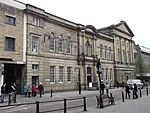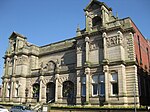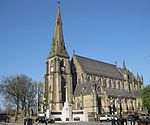
Sacred Heart Cathedral, located in Davenport, Iowa, United States, is a Catholic cathedral and a parish church in the Diocese of Davenport. The cathedral is located on a bluff overlooking the Mississippi River to the east of Downtown Davenport. It is listed on the National Register of Historic Places as part of the Sacred Heart Roman Catholic Cathedral Complex. This designation includes the church building, rectory, and the former convent, which was torn down in 2012. The cathedral is adjacent to the Cork Hill Historic District, also on the National Register. Its location on Cork Hill, a section of the city settled by Irish immigrants, gives the cathedral its nickname Cork Hill Cathedral.

Prestwich is a town in the Metropolitan Borough of Bury, Greater Manchester, England, 3.3 miles (5.3 km) north of Manchester city centre, 3.1 miles (5 km) north of Salford and 4.7 miles (7.6 km) south of Bury.

Saint Anne's Church serves in the Church of England the Soho section of London. It was consecrated on 21 March 1686 by Bishop Henry Compton as the parish church of the new civil and ecclesiastical parish of St Anne, created from part of the parish of St Martin in the Fields. The church is under the Deanery of Westminster in the Diocese of London.

St Philip & St James, Leckhampton is a parish in south Cheltenham, in the English county of Gloucestershire. Part of the Anglican Diocese of Gloucester, the church has been a centre for worship for more than 150 years and has a present congregational roll of over 200.
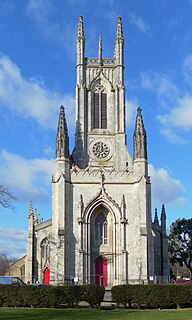
St Peter's Church is a church in Brighton in the English city of Brighton and Hove. It is near the centre of the city, on an island between two major roads, the A23 London Road and A270 Lewes Road. Built from 1824–28 to a design by Sir Charles Barry, it is arguably the finest example of the pre-Victorian Gothic Revival style. It is a Grade II* listed building. It was the parish church of Brighton from 1873 to 2007 and is sometimes unofficially referred to as "Brighton's cathedral".

Simister is a small suburb in the Metropolitan Borough of Bury, Greater Manchester, England. Historically part of Lancashire, it is located between the districts of Prestwich, Rhodes and Langley. Although the village's proximity to Manchester means the residential population is mainly made up of commuters, the village has a rural feel with much agricultural activity.

St Martin's Church is an Anglican church in Brighton, England, dating from the mid-Victorian era. It is located on the Lewes Road in the Round Hill area of the city, northeast of the city centre and approximately 1.1 miles (1.8 km) north of the seafront. It is the largest church in Brighton by capacity and is noted for its ornate interior.

The Church of St Mary the Virgin is in the village of Bowdon near Altrincham, Greater Manchester, England. It is recorded in the National Heritage List for England as a designated Grade II* listed building. It is an active Anglican parish church in the diocese of Chester, the archdeaconry of Macclesfield and the deanery of Bowdon.

The Church of St Mary the Virgin is on Church Lane, Prestwich, Greater Manchester, England. It is an active Anglican parish church in the deanery of Radcliffe and Prestwich, the archdeaconry of Bolton and the diocese of Manchester. The church is recorded in the National Heritage List for England as a designated Grade I listed building. Pevsner refers to it as "a major church".
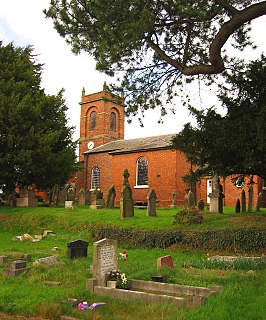
The Church of St Mary the Virgin is in the village of Wistaston, Cheshire, England. The church is recorded in the National Heritage List for England as a designated Grade II listed building. It is an active Anglican parish church in the diocese of Chester, the archdeaconry of Macclesfield and the deanery of Nantwich.
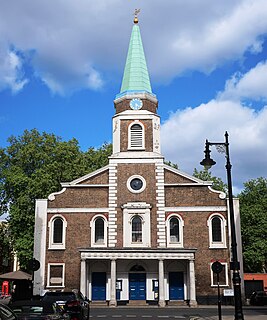
Grosvenor Chapel is an Anglican church in what is now the City of Westminster, in England, built in the 1730s. It inspired many churches in New England. It is situated on South Audley Street in Mayfair.

The Parish Church of St Mary the Virgin is a Church of England parish church in Leigh, Greater Manchester, England. It is a member of the Salford & Leigh deanery in the archdeaconry of Salford, diocese of Manchester. It is recorded in the National Heritage List for England as a designated Grade II* listed building.

St Mary's Church is a redundant Anglican church in St Mary's Place, Shrewsbury, Shropshire, England. It is recorded in the National Heritage List for England as a designated Grade I listed building, and is under the care of the Churches Conservation Trust, the Trust designated St Mary's as its first Conservation Church in 2015. It is the largest church in Shrewsbury. Clifton-Taylor includes the church in his list of 'best' English parish churches.

St. Alban's Church, Swaythling, Southampton, stands on Tulip Road, just off the main Burgess Road. The church, and its associated hall, is a Grade II listed building.

The Oratory Church of Saint Chad's, Manchester is a Grade II* listed Catholic church in Cheetham Hill, Manchester, England. It was constructed between 1846 and 1847, on the east side of Cheetham Hill Road. The parish functions under the jurisdiction of the Roman Catholic Diocese of Salford.

St Margaret's, Putney is situated in Putney Park Lane, Putney, London, England. It was designed by W. Allen Dixon in 1872. Prior to its dedication to St Margaret as an Anglican church it was first a Baptist and then a Presbyterian chapel under the name of Granard Chapel. It is part of the Wandsworth Deanery in the Southwark Diocese of the Church of England, and is also a member of Churches Together in Putney and Roehampton. It is a member of Inclusive Church and during Winter months it runs a homeless shelter once a week with Glass Door. The vicar is currently (2020) the Revd Dr Brutus Green.

The Church of St Michael and All Angels is a Church of England parish church in Great Torrington, Devon. It has been a Grade II* listed building since 1951.
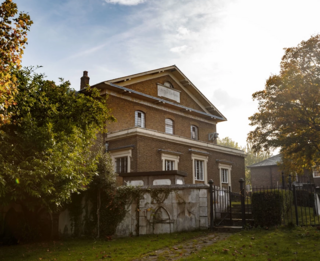
St Paul's Church is a Church of England parish church in Clapham, London. There has been a church on the site since the 12th century. The current building was completed in 1815 and is Grade II* listed. In the grounds, which hold the Green Flag Award, are some fine tombs including many early 19th century sarcophagi and a community garden, Eden. The incumbent is Revd Canon Jonathan Boardman.
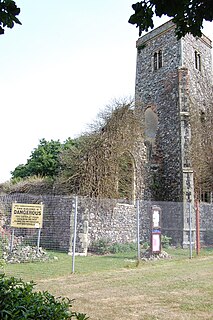
St Margaret's Church is the parish church of Hopton-on-Sea in the English county of Norfolk. It is dedicated to St Margaret of Antioch. St Margaret is also the dedication of the former church, which was destroyed by fire in 1865. The ruins of the former church remain standing, and are still consecrated. Both the old and new churches are Grade II* listed. Until 1974, Hopton-on-Sea was called Hopton ; the formal name for the benefice remains Hopton. The church is in the Diocese of Norwich, and is within the deanery of Lothingland and archdeaconry of Norfolk.
St Mary the Virgin Church is a parish church in Welling in the London Borough of Bexley. It is dedicated to the Virgin Mary. The church is in the Archdeaconry of Lewisham & Greenwich, in the Diocese of Southwark. It is notable for the range of 20th-century art contained within it.




















